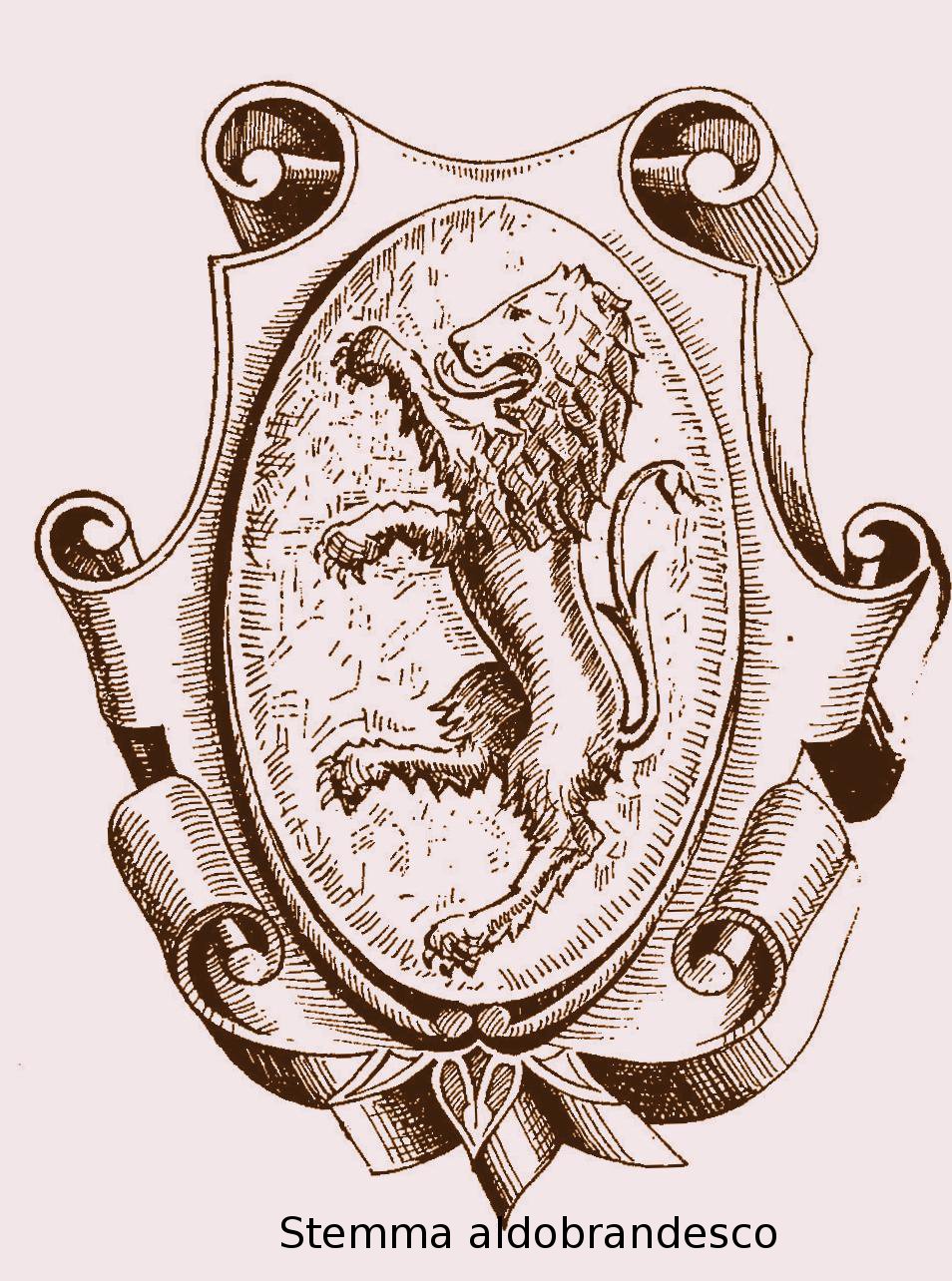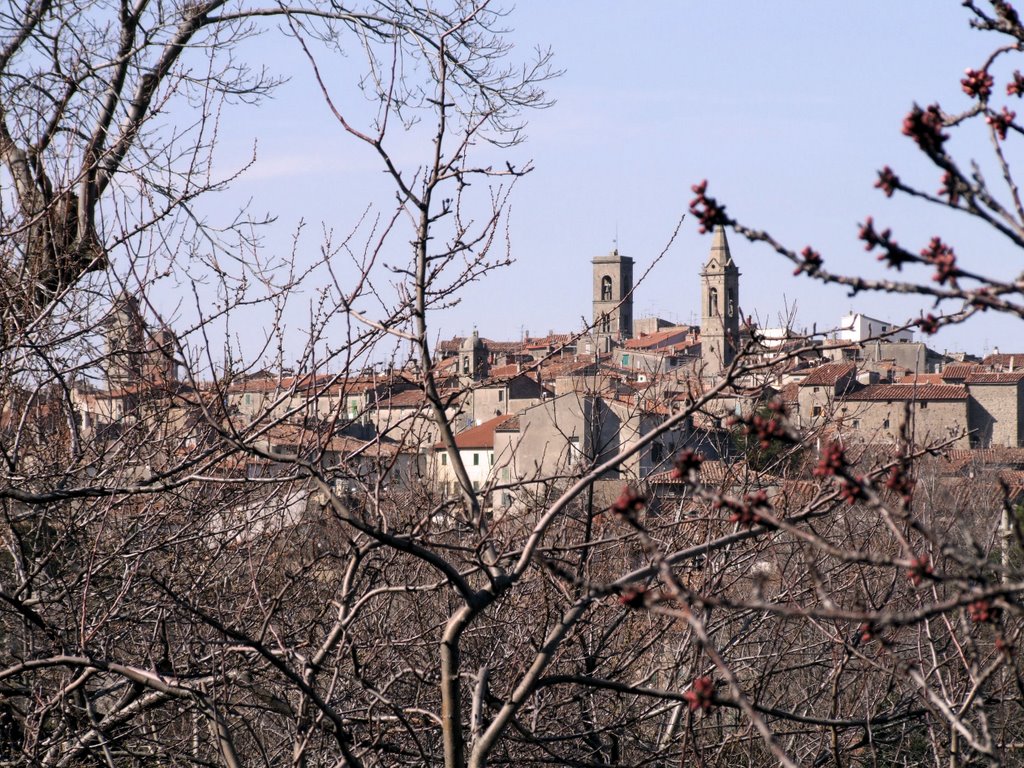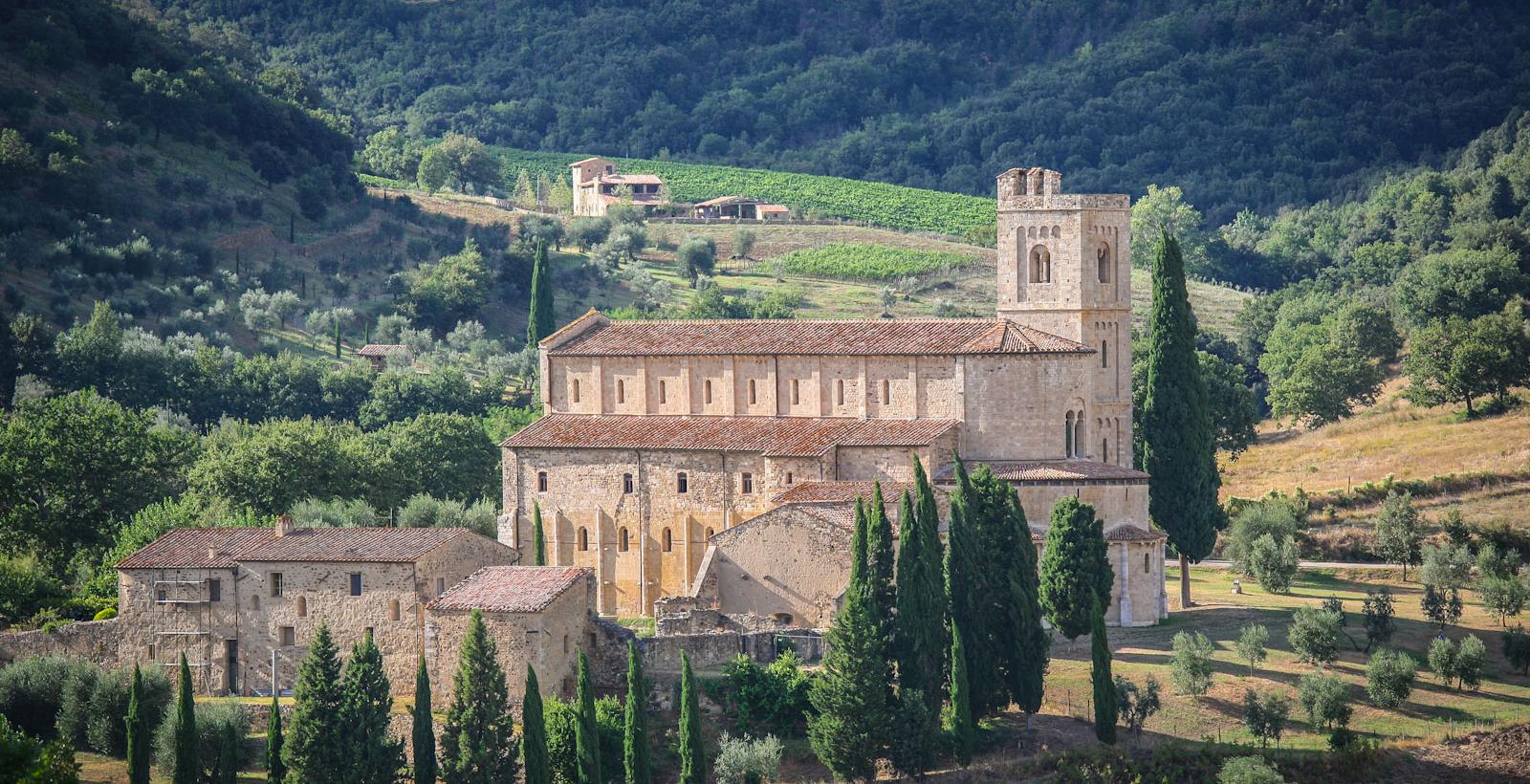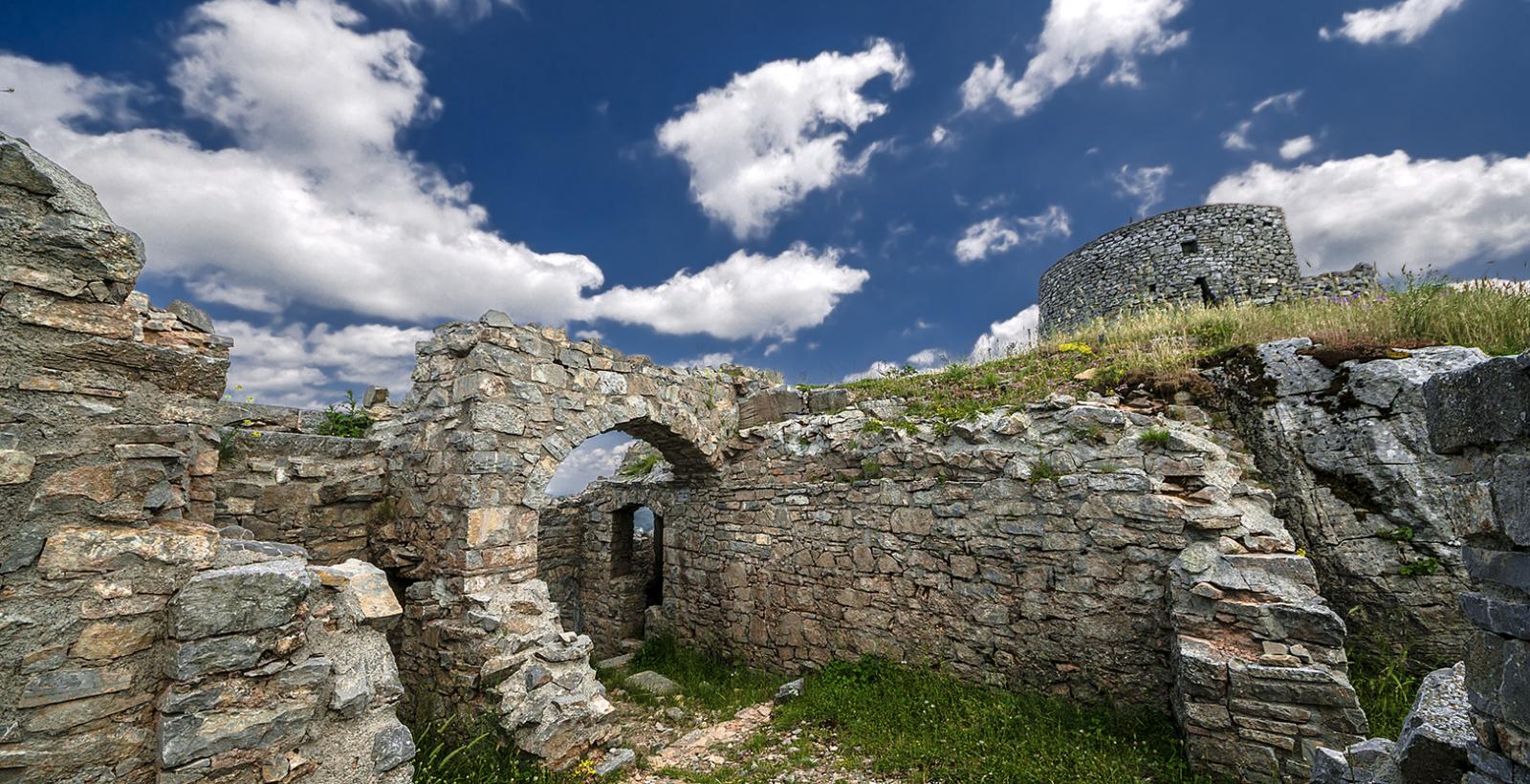Monuments, Architecture and visual arts
The municipality of Santa Fiora is bordered to the east with that of Piancastagnaio and west to Arcidosso. Includes the agglomeration of Santa Fiora, with a historical nucleus of great interest, and the villages of Bagnolo and Bagnore, today elegant centers of tourist attraction. Initially Santa Fiora was a possession of the Monaci di San Salvatore, but for a short time.
Before 1000 they settled the Aldobrandeschi, who made it the undisputed center of their vast manor, which in 1274 it was divided into two branches, both the aldobrandesca house, who took the name, as they are historically certificates "branch Sovana" and "branch of Santa Fiora." The latter competed throughout the Amiata area.
The combined effect of weddings, to the Aldobrandeschi of Santa Fiora, succeeded by the Sforza and later the Sforza-Cesarini, which they remained even when landowners took over domination Medici.
The old manor Aldobrandesco remains the austere clock tower, and adjacent to it the Palazzo Sforza-Cesarini, now the town hall, robed late Renaissance with a tunnel linking the Garibaldi Square with the streets of penetration to the country.
Along the way Carolina, the road that goes into the medieval part of the country, overlooking the front of the Parish of Saints Flora and Lucilla, a front cabin with canopy, looking sober, which coincides with the scene of the most important churches dell'Amiata. Inside some elegant mullioned windows in Gothic form I am supplied to the works of art of inestimable value, Robbiane's pottery dating back to the period from 1445 to 1510 approximately, attributable, without great hesitation, for stylistic forms and for analysis of the materials used, to Andrea della Robbia, master potter of the Florentine Renaissance. The topics of course are all sacred. It points out only the most important work that is the altarpiece depicting the "Assumption of the Virgin" is surrounded by a large crowd of angels and saints, but the series of glazed earthenware, namely Robbiane's pottery, in the walls and in the pulpit of the church, it is very conspicuous.
Also in the sacristy and in the rectory of the same time are stored vestments (paintings, holy shrine of Flora and Lucilla) the four hundred Sienese. In the lower part, towards the cliff that meets the valley, the church of Sant'Agostino, with some wood carvings, of exceptional artistic value, such as to attribute the performance to Jacopo della Quercia, or at least to his school, currently located in the Diocesan Museum of Pitigliano.
Still artistic works of the Sienese school, including a wooden crucifix and a painting fifteenth. Other temples, which complement the system of worship and active devotion of Santa Fiora of yesteryear,
are the Madonna del Suffragio, along the Via Carolina, with stucco eighteenth century, where are kept the three crucifixes in the trunk, that they are carried in solemn procession every May 3, according to an ancient tradition; la Madonna delle Nevi (where we find Francesco Nasini), located close to Peschiera, and the Convent of the Poor Clares, cloistered nuns, in which the choir is to be found a wooden crucifix of the fifteenth century Sienese.
Near the hamlet Selva, is the Franciscan Monastery of the Holy Trinity, a complex of great beauty, remote location in the middle of a forest of chestnut and oak trees, of uncertain origin, but restored in the eighteenth century, with a recovery lucky enough to paddle sixteenth, including the most important canvas, by Girolamo di Benvenuto depicting an "Assumption of the Virgin and the saints."
Nearby the cloister is stored in a bulletin board a legendary "dragon head" to evoke a hunting episode of Count Guido Sforza, obviously it attested by votive finding, but not from the chronicles of the time. Two architectural structures, a historical and civil, and the other linked to the cult, are present in the town of Arcidosso.
 The castle with crenellated tower, which will be built in the historical annals, even before 1000, now restored, has been a center of power before with the Aldobrandeschi, its head office, however, remained in Santa Fiora, then with the Republic of Siena, and later with the Grand Duchy of Tuscany, which they resided in the castle of Arcidosso the Captain of the People and the various consuls or mayor who administered a large area west of Amiata.
The castle with crenellated tower, which will be built in the historical annals, even before 1000, now restored, has been a center of power before with the Aldobrandeschi, its head office, however, remained in Santa Fiora, then with the Republic of Siena, and later with the Grand Duchy of Tuscany, which they resided in the castle of Arcidosso the Captain of the People and the various consuls or mayor who administered a large area west of Amiata.
The other structure, of sacred nature, is the Pieve di Lamulas sanctuary remembered as a possession of the abbots of San Salvatore, which was destroyed by the armies of Siena in 1264 and rebuilt soon after. Here too, restoration is not always well chosen, resulted in a succession of styles, from Romanesque exterior, art sober interior with some pretension in classical pillars, where animal motifs present in capitals recovered, are perhaps witnessing a Lombard origin of the complex. Now lost frescoes in the apse, although it remains on the altar a Madonna with Child wooden work fifteenth good Sienese school. Also interesting are the other churches of Arcidosso, from the sanctuary of Madonna Incoronata, where it is situated an important altarpiece by Ventura Salimbeni, known Sienese painter of the XVI century, whose baroque influences are very obvious, as well as an altarpiece depicting the Madonna and Child, by the Sienese school, tending to the style of Taddeo di Bartolo.
In the north of the village arcidossino should mention the church of San Leonardo, also original possession of the Abbey of San Salvatore, Francesco Vanni where he left one of his masterpieces, a "Decollazione di San Giovanni Battista", considered one of the most significant works of the seventeenth century Sienese devotional. In the same church there are various altarpieces dating back to five hundred authors refer to Siena, namely prior to the advent of Nasini, which strangely Arcidosso are found only in the peripheral of the Capuchin monastery and church in the sanctuary of Madonna Incoronata (only one copy of Raphael's Madonna of the Chair, Joseph Nicola Nasini). In the main street, near the old village, a remarkable cast iron fountain, like a temple is to highlight an unusual history linked to a compensatory appropriation, that is, the transfer of water from the city of Grosseto Arcidosso and the center of Follonica in exchange for a work of blacksmiths, Active in the nineteenth century in Follonica. On the way to Castel del piano, adjacent to the town of San Lorenzo, it is the Capuchin Monastery, whose church contains a painting dated 1593 by Francesco Vanni, depicting Madonna and Saints and placed on the high altar.
Note in this canvas a recovery of original polychrome which surprises for its liveliness and recording the clever use of color by an author who has left signals prestigious talent in the city of Siena and its surroundings. A Montelaterone the parish church of St. Clement retains altar left a valuable painting of the Sienese school, dating from the seventeenth century. To left of the main altar there is a marble tabernacle, assigned to the Sienese masters of the fifteenth century. In Misericordia church frescoes referring to Francesco Nasini. Castel del piano urban physiognomy has a very respectable with a pleasant space distribution and construction sequences historically ordered. The plateau that gives the village its name is crossed by Nasini and heads south and south-west a building expansion balanced. Upstream of course Nasini is the old town. The center of Castel del piano plays characters monumental conferred by two churches, of different ages, in which the intervention is constructive is smeared in time, especially for the Church of Saints Niccolò and Lucia, also known as Church of the Opera. The church of Madonna delle Grazie is a monumental building, the nineteenth century facade with baroque cross-reference, to complete a square of elegant look spectacular.
The church of the Opera has within it a considerable artistic endowment, where next to figurative works of Domenico Manetti (Siena, active in the mid-seventeenth century), and Alessandro Casolani ("Beheading of Saint John the Baptist"), the dynasty Nasini, originating in the place, expressed a production of paintings and frescoes rich in quality and quantity. Of all reported to be a "Nativity of Mary" by Giuseppe Nicola Nasini, which it is perhaps one of the best works of this painter, who - in turn - among Nasini was more refined and more open environments stylistic era.
The family of Nasini had to practice painting on both walls (frescoes), both on canvas, in the years from the mid-seventeenth century to the mid-eighteenth century, exercising that artistic activity with a production very abundant and distributed in various areas: first of all in the centers dell'Amiata, but also in Siena, Florence and Rome, however, accepting commissions where they were required. The founder of the painters nasiniani was Francesco, followed by his brother Hannibal and his sons Antonio and Giuseppe Nicola, which is recognized by critics the greatest artistic quality. Finally the children of Joseph Nicola Nasini, James and Apollonius. An overall assessment of the work of Nasini should refer especially to Joseph Nicola, summarizing in artistic terms, the best that represented by others, from Francesco Nasini. Their art was mainly a search and a revival of stylistic echoes of the most important artistic trends of the time, so it is not hard to find in the works of Giuseppe Nicola baroque influences, but also Caravaggio, especially in expressions luministic. In many paintings it is found the presence of tones aesthetic and mannerist painters of the Veneto and Emilia, that the painter himself had often to attend, but it is still dominant domestic and devotional art that tends to mitigate the excesses classicist era, often with positive results. Francesco Nasini is instead paid more in search of the overcoming of the baroque splendor, introducing in his works components intimating almost primitive, such as to suggest to the Neapolitan mannerisms seen in the ex-voto or otherwise in less devotional art of the time. As for the technique of drawing, to the effects of light, the properties of color, only Giuseppe Nicola Nasini deserves to be considered a master of the brush, even if it not always expressed high levels of production, especially for the over-abundance of works from his studio in Siena. The same goes Giuseppe Nicola Nasini then recalled for the paintings of the Last Things, a series of paintings including four images (death, judgment, heaven, hell), who were exposed to more than a century in a hall of Palazzo Pitti in Florence, starting from 1690 by Cosimo III de 'Medici, proving a success in contemporary dramatic and emotional of ample proportions. In front of the church of the Opera, which preserves, as we have seen a series of works nasiniani, it is the temple of Madonna delle Grazie, whose altar, exuding a scene totally baroque, however artistically it redeemed by a "Madonna with Child and Saints", which is certainly to be credited to Sano di Pietro, active in Siena in the fifteenth century, or at least at his school. Even in this temple there are, and it could not be otherwise, nasini's paintings.
In the parish church of Montegiovi, a pleasant village situated on a hill west of Amiata, are found works creditable Nasini Francesco and his descendants.
More interesting from an artistic artefacts present in Montenero d'Orcia, another hamlet of Castel del Piano. A port with machicolated testifies to the existence of fortifications reconstructed only in a virtual way. The church of Saint Lucia, small and basic, glimpse quality paintings appreciated that while not referring to authors definitely identified, reveal the influence of Sienese art from various periods, including a Christ on the cross attributed with a certain approximation, but with very valid reasons, Ambrogio Lorenzetti. In Monticello Amiata, in the parish church, it is to be found a "Madonna Enthroned" by Bartolomeo Neroni, said Riccio, Sienese painter of the sixteenth century, follower of Sodom. In the chapel of Val di Prata we find work promptly Nasini, this time of Giuseppe Nicola, depicting a series of sacred figures. But a sequence of works of art that deserves great attention is to be found in Seggiano, amiatino born as a village house of the Monastery of San Salvatore, then it became a possession of the Republic of Siena before the territorial gains of Amiatine Guidoriccio from Fogliano.
Worth here to remember a series of frescoes, obviously all about the sacred, of Girolamo di Domenico, in the small chapel of San Rocco, just outside the town.
Girolamo di Domenico, famous painter of the late fifteenth century Sienese, in producing such frescoes he has felt the influences of Umbria, making a remarkable artistic synthesis between two schools of high decorative value. The "Master of Panzano", also fourteenth century Sienese, highlights an altarpiece in sacred theme, in Town Hall.
Still a great figurative art of the fourteenth century Sienese, first identified as a "master Sheepfold" and more recently in Bartolomeo Bulgarini, is the author of an altarpiece with a "Virgin and Child Enthroned with Saints", located in the parish church of San Bartolomeo.
At the top of the village, the church of Corpus Christi has paintings of the Sienese school, and a number of relics from the Convent of Colombaio, in which he had to carry out his work mystical and meditative San Bernardino of Siena.
 On the way to Castel del piano we find a place of worship from the elegant architectural form dating from the late sixteenth century, the Shrine of Madonna della Carità, with a pretentious facade and high-quality decorations. On the road to Castiglione d'Orcia, the left deviations road leading to the Castle of Potentino, possession of the monks of San Salvatore, well preserved over time and now restored.
On the way to Castel del piano we find a place of worship from the elegant architectural form dating from the late sixteenth century, the Shrine of Madonna della Carità, with a pretentious facade and high-quality decorations. On the road to Castiglione d'Orcia, the left deviations road leading to the Castle of Potentino, possession of the monks of San Salvatore, well preserved over time and now restored.
Not far from the ruins of the Convent of Colombaio, that was probably one of the first examples of monasticism, founded by St. Francis in Tuscany in 1221, where in the fifteenth century he was active and contemplative mysticism for a long time San Bernardino Albizzeschi, so that the monastery is often referred to in the post-medieval chronicles as the Convent of San Bernardino of Siena.
Above Seggiano, between the woods and the silence of the mountain, it is the fraction of Pescina, in whose parish church is a painting depicting a "Virgin and Child", accredited to brush of Luca di Tommè, among the most significant artists of the fourteenth century Sienese.
Castiglione d'Orcia, a medieval fortified town, whose remaining remnants of walls with doors and two towers,it is placed in a middle tier between Amiata and Val d'Orcia, with breathtaking valleys of great emotional impact, those views that are the symbol of the Tuscan landscape, with grasslands, crete, rows of cypress trees and farmhouses or country houses. The oldest part of the village is discernible in the square of Vecchietta, which is overlooked by the Town Hall, a well of the '600 and other historic buildings.
Il Vecchietta, that Lorenzo di Pietro, known and talented painter active in four of Siena, it is a native of this village, and for this reason, the town's main square is named after him. But a very special relief assumes the Church of Saints Stephen and Worthy, which has an endowment artistic entirely uncommon for quality and reputation of the authors, three works of capital importance of Sienese painting: a "Madonna and Child with Angels" of the same Vecchietta, another "Madonna with Child" by Pietro Lorenzetti and even a "Madonna" recently attributed by critics to the most authoritative Simone Martini. Unfortunately these works are now considered to be of high artistic value, are no longer in their original location.
For reasons of safety and greater suitable conservation, after being displaced for a few years at the Superintendency of Siena and Grosseto, are now assigned to the nearby Museum of Montalcino. However, it remains assigned to the parish church of Saints Peter and Paul, in Roccalbegna, an altarpiece by Ambrogio Lorenzetti, dated around 1340, depicting a "Madonna and Child with Saints Peter and Paul", of high artistic value, enough to be qualified as one of the masterpieces of the illustrious author. It deserves also a dutiful nod oratory behind the church, which houses a small collection of paintings to sacred theme, including a cross from Luca Tommè, distinguished author of three hundred Siena, and an exhibition of paintings of the usual Nasini.
A Semproniano, temples seventeenth century in the historic center and near the village, with precious holy water fonts. Located on a rocky outcrop, guarding the gorges of Albegna, the small but intact village of Rocchette di Fazio, with ancient buildings, such as the Praetorian Palace and the Hospital of St. Bartholomew, dates back to 1330. Near the remains of the fortress aldobrandesca, presents a vast and complex panorama that sweeps from the wild cliffs of Albegna the extreme southern highlands of Mount Amiata, in a rough grid of rocks and vegetation.
(Main source of reference: Bruno Santi, "Il Monte Amiata, itinerario storico-artistico", Lions Club Amiata, 1987)
Before 1000 they settled the Aldobrandeschi, who made it the undisputed center of their vast manor, which in 1274 it was divided into two branches, both the aldobrandesca house, who took the name, as they are historically certificates "branch Sovana" and "branch of Santa Fiora." The latter competed throughout the Amiata area.
The combined effect of weddings, to the Aldobrandeschi of Santa Fiora, succeeded by the Sforza and later the Sforza-Cesarini, which they remained even when landowners took over domination Medici.
The old manor Aldobrandesco remains the austere clock tower, and adjacent to it the Palazzo Sforza-Cesarini, now the town hall, robed late Renaissance with a tunnel linking the Garibaldi Square with the streets of penetration to the country.
Along the way Carolina, the road that goes into the medieval part of the country, overlooking the front of the Parish of Saints Flora and Lucilla, a front cabin with canopy, looking sober, which coincides with the scene of the most important churches dell'Amiata. Inside some elegant mullioned windows in Gothic form I am supplied to the works of art of inestimable value, Robbiane's pottery dating back to the period from 1445 to 1510 approximately, attributable, without great hesitation, for stylistic forms and for analysis of the materials used, to Andrea della Robbia, master potter of the Florentine Renaissance. The topics of course are all sacred. It points out only the most important work that is the altarpiece depicting the "Assumption of the Virgin" is surrounded by a large crowd of angels and saints, but the series of glazed earthenware, namely Robbiane's pottery, in the walls and in the pulpit of the church, it is very conspicuous.
Also in the sacristy and in the rectory of the same time are stored vestments (paintings, holy shrine of Flora and Lucilla) the four hundred Sienese. In the lower part, towards the cliff that meets the valley, the church of Sant'Agostino, with some wood carvings, of exceptional artistic value, such as to attribute the performance to Jacopo della Quercia, or at least to his school, currently located in the Diocesan Museum of Pitigliano.
Still artistic works of the Sienese school, including a wooden crucifix and a painting fifteenth. Other temples, which complement the system of worship and active devotion of Santa Fiora of yesteryear,
are the Madonna del Suffragio, along the Via Carolina, with stucco eighteenth century, where are kept the three crucifixes in the trunk, that they are carried in solemn procession every May 3, according to an ancient tradition; la Madonna delle Nevi (where we find Francesco Nasini), located close to Peschiera, and the Convent of the Poor Clares, cloistered nuns, in which the choir is to be found a wooden crucifix of the fifteenth century Sienese.
Near the hamlet Selva, is the Franciscan Monastery of the Holy Trinity, a complex of great beauty, remote location in the middle of a forest of chestnut and oak trees, of uncertain origin, but restored in the eighteenth century, with a recovery lucky enough to paddle sixteenth, including the most important canvas, by Girolamo di Benvenuto depicting an "Assumption of the Virgin and the saints."
Nearby the cloister is stored in a bulletin board a legendary "dragon head" to evoke a hunting episode of Count Guido Sforza, obviously it attested by votive finding, but not from the chronicles of the time. Two architectural structures, a historical and civil, and the other linked to the cult, are present in the town of Arcidosso.
 The castle with crenellated tower, which will be built in the historical annals, even before 1000, now restored, has been a center of power before with the Aldobrandeschi, its head office, however, remained in Santa Fiora, then with the Republic of Siena, and later with the Grand Duchy of Tuscany, which they resided in the castle of Arcidosso the Captain of the People and the various consuls or mayor who administered a large area west of Amiata.
The castle with crenellated tower, which will be built in the historical annals, even before 1000, now restored, has been a center of power before with the Aldobrandeschi, its head office, however, remained in Santa Fiora, then with the Republic of Siena, and later with the Grand Duchy of Tuscany, which they resided in the castle of Arcidosso the Captain of the People and the various consuls or mayor who administered a large area west of Amiata.The other structure, of sacred nature, is the Pieve di Lamulas sanctuary remembered as a possession of the abbots of San Salvatore, which was destroyed by the armies of Siena in 1264 and rebuilt soon after. Here too, restoration is not always well chosen, resulted in a succession of styles, from Romanesque exterior, art sober interior with some pretension in classical pillars, where animal motifs present in capitals recovered, are perhaps witnessing a Lombard origin of the complex. Now lost frescoes in the apse, although it remains on the altar a Madonna with Child wooden work fifteenth good Sienese school. Also interesting are the other churches of Arcidosso, from the sanctuary of Madonna Incoronata, where it is situated an important altarpiece by Ventura Salimbeni, known Sienese painter of the XVI century, whose baroque influences are very obvious, as well as an altarpiece depicting the Madonna and Child, by the Sienese school, tending to the style of Taddeo di Bartolo.
In the north of the village arcidossino should mention the church of San Leonardo, also original possession of the Abbey of San Salvatore, Francesco Vanni where he left one of his masterpieces, a "Decollazione di San Giovanni Battista", considered one of the most significant works of the seventeenth century Sienese devotional. In the same church there are various altarpieces dating back to five hundred authors refer to Siena, namely prior to the advent of Nasini, which strangely Arcidosso are found only in the peripheral of the Capuchin monastery and church in the sanctuary of Madonna Incoronata (only one copy of Raphael's Madonna of the Chair, Joseph Nicola Nasini). In the main street, near the old village, a remarkable cast iron fountain, like a temple is to highlight an unusual history linked to a compensatory appropriation, that is, the transfer of water from the city of Grosseto Arcidosso and the center of Follonica in exchange for a work of blacksmiths, Active in the nineteenth century in Follonica. On the way to Castel del piano, adjacent to the town of San Lorenzo, it is the Capuchin Monastery, whose church contains a painting dated 1593 by Francesco Vanni, depicting Madonna and Saints and placed on the high altar.
Note in this canvas a recovery of original polychrome which surprises for its liveliness and recording the clever use of color by an author who has left signals prestigious talent in the city of Siena and its surroundings. A Montelaterone the parish church of St. Clement retains altar left a valuable painting of the Sienese school, dating from the seventeenth century. To left of the main altar there is a marble tabernacle, assigned to the Sienese masters of the fifteenth century. In Misericordia church frescoes referring to Francesco Nasini. Castel del piano urban physiognomy has a very respectable with a pleasant space distribution and construction sequences historically ordered. The plateau that gives the village its name is crossed by Nasini and heads south and south-west a building expansion balanced. Upstream of course Nasini is the old town. The center of Castel del piano plays characters monumental conferred by two churches, of different ages, in which the intervention is constructive is smeared in time, especially for the Church of Saints Niccolò and Lucia, also known as Church of the Opera. The church of Madonna delle Grazie is a monumental building, the nineteenth century facade with baroque cross-reference, to complete a square of elegant look spectacular.
The church of the Opera has within it a considerable artistic endowment, where next to figurative works of Domenico Manetti (Siena, active in the mid-seventeenth century), and Alessandro Casolani ("Beheading of Saint John the Baptist"), the dynasty Nasini, originating in the place, expressed a production of paintings and frescoes rich in quality and quantity. Of all reported to be a "Nativity of Mary" by Giuseppe Nicola Nasini, which it is perhaps one of the best works of this painter, who - in turn - among Nasini was more refined and more open environments stylistic era.
The family of Nasini had to practice painting on both walls (frescoes), both on canvas, in the years from the mid-seventeenth century to the mid-eighteenth century, exercising that artistic activity with a production very abundant and distributed in various areas: first of all in the centers dell'Amiata, but also in Siena, Florence and Rome, however, accepting commissions where they were required. The founder of the painters nasiniani was Francesco, followed by his brother Hannibal and his sons Antonio and Giuseppe Nicola, which is recognized by critics the greatest artistic quality. Finally the children of Joseph Nicola Nasini, James and Apollonius. An overall assessment of the work of Nasini should refer especially to Joseph Nicola, summarizing in artistic terms, the best that represented by others, from Francesco Nasini. Their art was mainly a search and a revival of stylistic echoes of the most important artistic trends of the time, so it is not hard to find in the works of Giuseppe Nicola baroque influences, but also Caravaggio, especially in expressions luministic. In many paintings it is found the presence of tones aesthetic and mannerist painters of the Veneto and Emilia, that the painter himself had often to attend, but it is still dominant domestic and devotional art that tends to mitigate the excesses classicist era, often with positive results. Francesco Nasini is instead paid more in search of the overcoming of the baroque splendor, introducing in his works components intimating almost primitive, such as to suggest to the Neapolitan mannerisms seen in the ex-voto or otherwise in less devotional art of the time. As for the technique of drawing, to the effects of light, the properties of color, only Giuseppe Nicola Nasini deserves to be considered a master of the brush, even if it not always expressed high levels of production, especially for the over-abundance of works from his studio in Siena. The same goes Giuseppe Nicola Nasini then recalled for the paintings of the Last Things, a series of paintings including four images (death, judgment, heaven, hell), who were exposed to more than a century in a hall of Palazzo Pitti in Florence, starting from 1690 by Cosimo III de 'Medici, proving a success in contemporary dramatic and emotional of ample proportions. In front of the church of the Opera, which preserves, as we have seen a series of works nasiniani, it is the temple of Madonna delle Grazie, whose altar, exuding a scene totally baroque, however artistically it redeemed by a "Madonna with Child and Saints", which is certainly to be credited to Sano di Pietro, active in Siena in the fifteenth century, or at least at his school. Even in this temple there are, and it could not be otherwise, nasini's paintings.
In the parish church of Montegiovi, a pleasant village situated on a hill west of Amiata, are found works creditable Nasini Francesco and his descendants.
More interesting from an artistic artefacts present in Montenero d'Orcia, another hamlet of Castel del Piano. A port with machicolated testifies to the existence of fortifications reconstructed only in a virtual way. The church of Saint Lucia, small and basic, glimpse quality paintings appreciated that while not referring to authors definitely identified, reveal the influence of Sienese art from various periods, including a Christ on the cross attributed with a certain approximation, but with very valid reasons, Ambrogio Lorenzetti. In Monticello Amiata, in the parish church, it is to be found a "Madonna Enthroned" by Bartolomeo Neroni, said Riccio, Sienese painter of the sixteenth century, follower of Sodom. In the chapel of Val di Prata we find work promptly Nasini, this time of Giuseppe Nicola, depicting a series of sacred figures. But a sequence of works of art that deserves great attention is to be found in Seggiano, amiatino born as a village house of the Monastery of San Salvatore, then it became a possession of the Republic of Siena before the territorial gains of Amiatine Guidoriccio from Fogliano.
Worth here to remember a series of frescoes, obviously all about the sacred, of Girolamo di Domenico, in the small chapel of San Rocco, just outside the town.
Girolamo di Domenico, famous painter of the late fifteenth century Sienese, in producing such frescoes he has felt the influences of Umbria, making a remarkable artistic synthesis between two schools of high decorative value. The "Master of Panzano", also fourteenth century Sienese, highlights an altarpiece in sacred theme, in Town Hall.
Still a great figurative art of the fourteenth century Sienese, first identified as a "master Sheepfold" and more recently in Bartolomeo Bulgarini, is the author of an altarpiece with a "Virgin and Child Enthroned with Saints", located in the parish church of San Bartolomeo.
At the top of the village, the church of Corpus Christi has paintings of the Sienese school, and a number of relics from the Convent of Colombaio, in which he had to carry out his work mystical and meditative San Bernardino of Siena.
 On the way to Castel del piano we find a place of worship from the elegant architectural form dating from the late sixteenth century, the Shrine of Madonna della Carità, with a pretentious facade and high-quality decorations. On the road to Castiglione d'Orcia, the left deviations road leading to the Castle of Potentino, possession of the monks of San Salvatore, well preserved over time and now restored.
On the way to Castel del piano we find a place of worship from the elegant architectural form dating from the late sixteenth century, the Shrine of Madonna della Carità, with a pretentious facade and high-quality decorations. On the road to Castiglione d'Orcia, the left deviations road leading to the Castle of Potentino, possession of the monks of San Salvatore, well preserved over time and now restored.Not far from the ruins of the Convent of Colombaio, that was probably one of the first examples of monasticism, founded by St. Francis in Tuscany in 1221, where in the fifteenth century he was active and contemplative mysticism for a long time San Bernardino Albizzeschi, so that the monastery is often referred to in the post-medieval chronicles as the Convent of San Bernardino of Siena.
Above Seggiano, between the woods and the silence of the mountain, it is the fraction of Pescina, in whose parish church is a painting depicting a "Virgin and Child", accredited to brush of Luca di Tommè, among the most significant artists of the fourteenth century Sienese.
Castiglione d'Orcia, a medieval fortified town, whose remaining remnants of walls with doors and two towers,it is placed in a middle tier between Amiata and Val d'Orcia, with breathtaking valleys of great emotional impact, those views that are the symbol of the Tuscan landscape, with grasslands, crete, rows of cypress trees and farmhouses or country houses. The oldest part of the village is discernible in the square of Vecchietta, which is overlooked by the Town Hall, a well of the '600 and other historic buildings.
Il Vecchietta, that Lorenzo di Pietro, known and talented painter active in four of Siena, it is a native of this village, and for this reason, the town's main square is named after him. But a very special relief assumes the Church of Saints Stephen and Worthy, which has an endowment artistic entirely uncommon for quality and reputation of the authors, three works of capital importance of Sienese painting: a "Madonna and Child with Angels" of the same Vecchietta, another "Madonna with Child" by Pietro Lorenzetti and even a "Madonna" recently attributed by critics to the most authoritative Simone Martini. Unfortunately these works are now considered to be of high artistic value, are no longer in their original location.
For reasons of safety and greater suitable conservation, after being displaced for a few years at the Superintendency of Siena and Grosseto, are now assigned to the nearby Museum of Montalcino. However, it remains assigned to the parish church of Saints Peter and Paul, in Roccalbegna, an altarpiece by Ambrogio Lorenzetti, dated around 1340, depicting a "Madonna and Child with Saints Peter and Paul", of high artistic value, enough to be qualified as one of the masterpieces of the illustrious author. It deserves also a dutiful nod oratory behind the church, which houses a small collection of paintings to sacred theme, including a cross from Luca Tommè, distinguished author of three hundred Siena, and an exhibition of paintings of the usual Nasini.
A Semproniano, temples seventeenth century in the historic center and near the village, with precious holy water fonts. Located on a rocky outcrop, guarding the gorges of Albegna, the small but intact village of Rocchette di Fazio, with ancient buildings, such as the Praetorian Palace and the Hospital of St. Bartholomew, dates back to 1330. Near the remains of the fortress aldobrandesca, presents a vast and complex panorama that sweeps from the wild cliffs of Albegna the extreme southern highlands of Mount Amiata, in a rough grid of rocks and vegetation.
(Main source of reference: Bruno Santi, "Il Monte Amiata, itinerario storico-artistico", Lions Club Amiata, 1987)
"They run for the mountains in large quantities clear water sources from places such delicious that nymphs and fauns have never found the most beautiful, and these waters form streams that make the land fertile and always fresh and that no other mountain can stand the comparison; and i the judge in the delights, in the goodness of water and air, ...not inferior to those of Greece, that the ancient poets deified in their songs. There, the summer does not take place and his place is occupied by the most charming of the springs; there the bird sweeter his singing, and the flower more alive its color and more tenacious her perfume".
(Pope Pius II, Commentaries, IX) AMIATA, MOUNTAIN MOTHER






FIND US ON AND
AND 